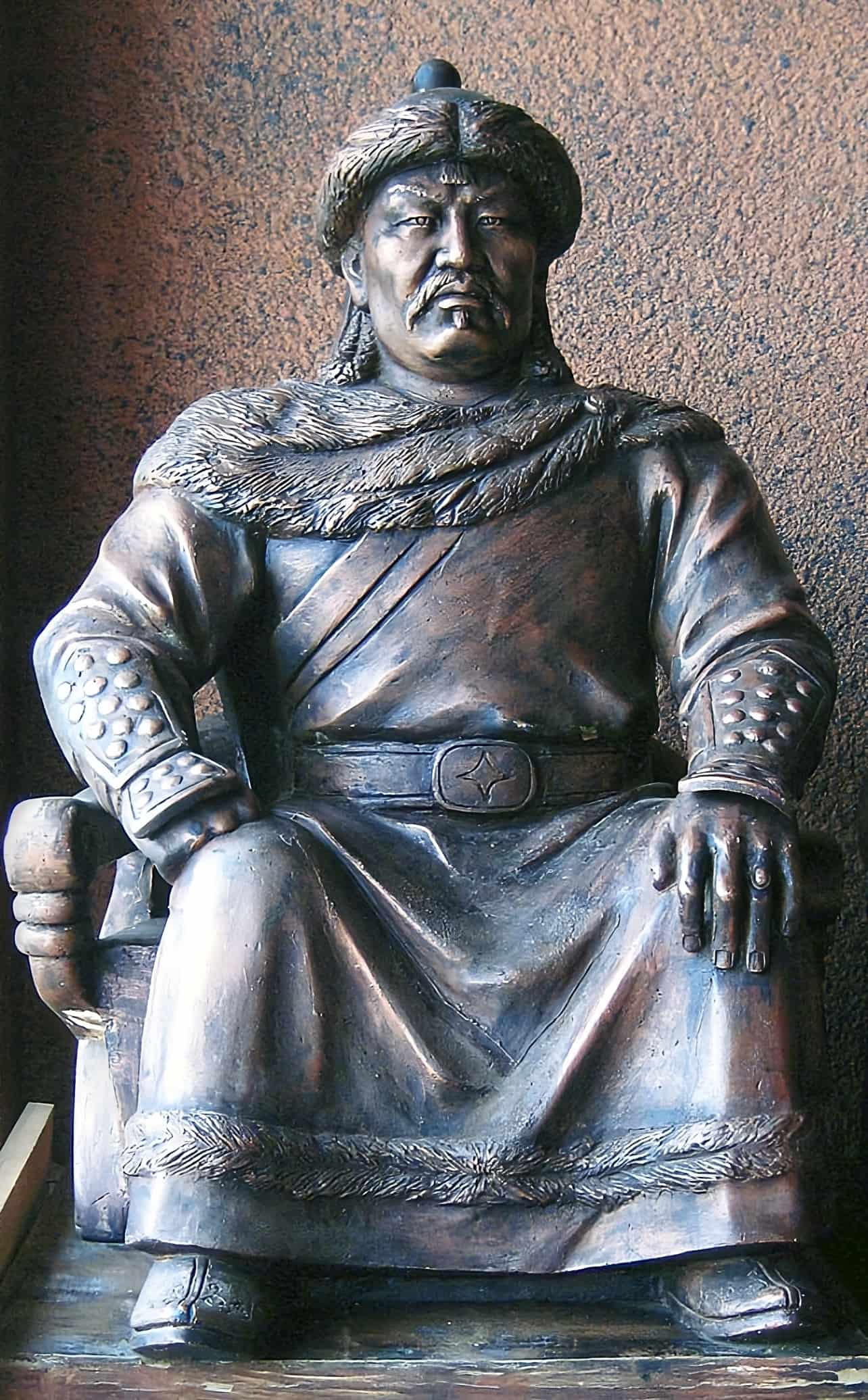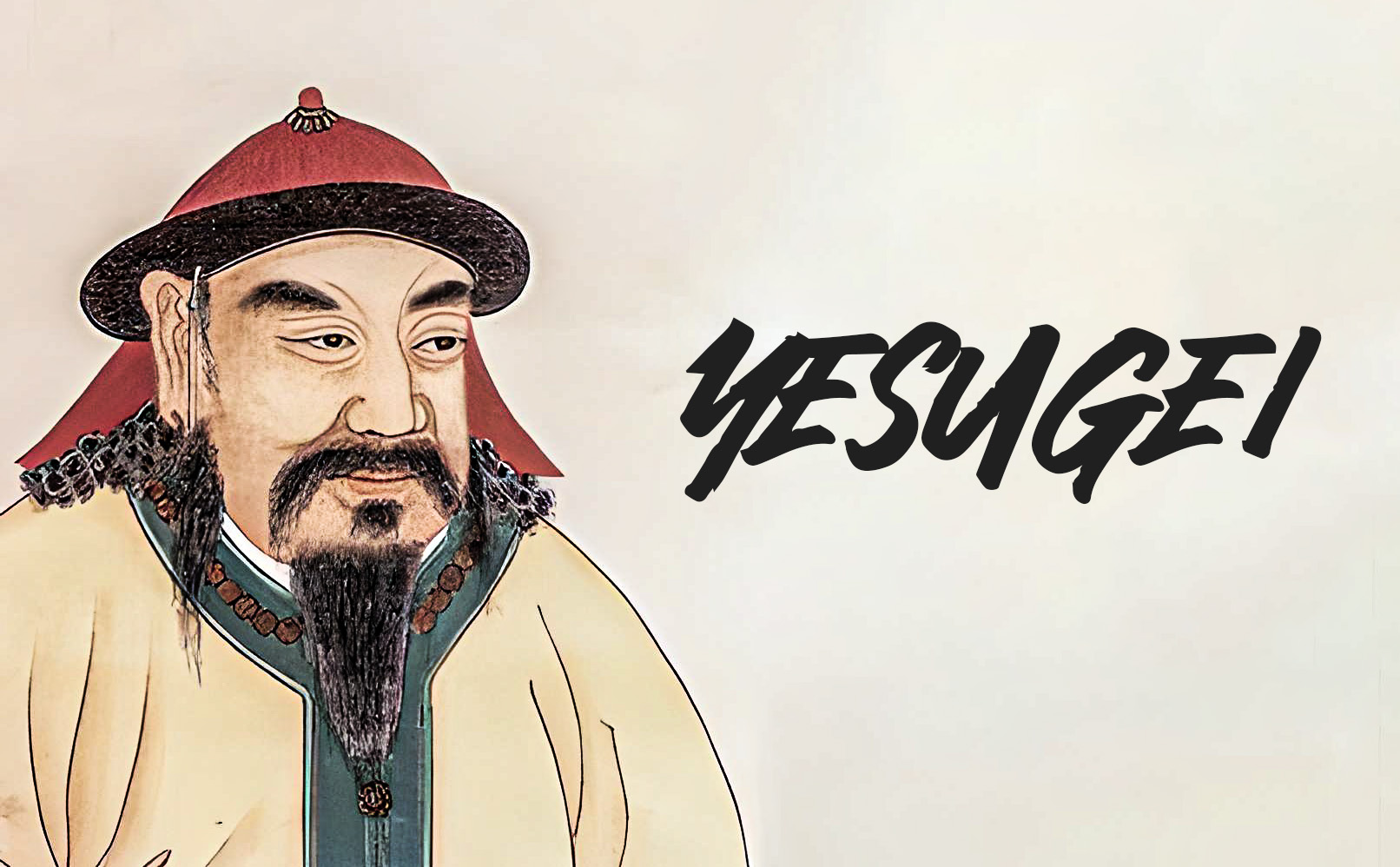The Kiyat group, a Mongol people, was located in the northeastern portion of the Mongolian steppe in the mid-12th century, and its clan chief, Yesugei, or Yesükhei in Mongolian (Есүхэй, ᠶᠢᠰᠦᠭᠡᠢ), was a powerful figure in the clan. Genghis Khan’s father and the progenitor of the Kiyat-Borjigin family, Yesugei (b. 1134 – d. 1171), is credited with establishing Mongol rule. He held the position of Baghatur, which means “hero” or “noble one”, so he was commonly referred to as Yesugei Baghatur. It was an honorable title given to the nomadic warriors who distinguished themselves in battle, but it later became a certain title bestowed by the Khan.
Meaning of the Name Yesugei
The name “Yesugei” means “like nine,” which alludes to the fact that the Mongols consider nine (yesün) to be a fortunate number. While “yesügei” is masculine, the feminine form of the same name is “yesülün.” Similar to his ancestors, Yesugei believed in Tengrism, one of the first monotheistic religions on Earth.
Yesugei’s Family, Wife, and Children
Yesugei was one of the four sons of Bartan Baghatur (1120–1161). The eldest is Möngke Kiyan, followed by Negün Taishi, and the youngest is Daridai Otchigin. Möngke was Yesugei’s elder brother, and Negün and Daridai were his younger brothers.
- Children From Hoelun
- Temüjin (Genghis Khan)
- Jochi Qasar
- Hachiun Alchi
- Temuge Otchigin (Otchigin means the “youngest”)
- Temülin (daughter)
- Children From Sochigel
- Behter
- Belgutei
Origin of Yesugei

Yesugei’s father Bartan Baghatur was the second son of Khabul Khan (1100–1148). Khabul Khan, Yesugei’s grandfather, was the first pan-Mongol khan. He had seven sons who gave rise to the Kiyat tribe, one of the two ancestral tribes of Genghis Khan’s family.
Despite having so many direct heirs, Khabul Khan left the rule to his second cousin, Ambaghai. The relationship between Khabul Khan and Ambaghai goes back to their common great-grandfather Kaidu (1025–1100).
Kaidu had three sons: Bashinkhor Dogshin, Charaqai Lingqum, and Chaojin-Ortegai. Khabul Khan was the grandson of Bashinkhor Khan, and Ambaghai was the grandson of Charaqai. Ambaghai Khan and other descendants of Charaqai Lingqum founded the Taichiud clan in 1148.
In the later decades, it would be the same Taichiud clan that ambushed Yesugei’s helpless family, captured Temüjin, and chained him up with a neck cangue used for slaves.
The next khan, the fourth son of Khabul Khan was Hotula Khan (1111–1161), who was the uncle of Yesugei. Ambaghai Khan (Khabul Khan’s cousin), the leader of the Khamag Mongols (“the Whole Mongols”), was killed by the Jin dynasty after being conspired against by the Tatar tribe’s border garrison. This was long before Yesugei was born in 1134. And Yesugei died in 1171 after being poisoned by Tatars on his way back home.
Early Life of Yesugei

While out falconeering near the Onon River, Yesugei met Yeke Chiledu, a Merkit man who had recently married an Olkhonud woman. Yesugei thought the lady was a rare beauty, so he invited his elder and younger brothers, Negün Taishi and Daridai Otchigin, to come to check her out.
Afraid, Yeke Chiledu fled away, but his three siblings gave pursuit. Hoelun, the girl, warned Yeke Chiledu to abandon her and run away because three siblings were out to murder him: “Those three are trying to kill you, and as long as you are alive, you can meet another woman. Don’t lay down your life, leave me behind.” And just like that, Hoelun let Yeke Chiledu run. Later, the three siblings kidnapped Hoelun and married her brother Yesugei.
As a sign of great respect, Yesüdei made Hoelun his only primary wife. Thus, only Hoelun could bore child to the clan chieftain.
According to one account, Ambaghai Khan once traveled to the Tatars in person to marry his son Qadaan Taishi to the daughter of the Airu’ut Tatar leader. But the Tatars betrayed him and delivered him to the Jurchen leader Altan Khan Ulu, who promptly had him killed. In alternate narratives, he traveled to the Tatars either to pick out a bride from among the local women or to see off his daughter, who was getting married.
Either way, Altan Khan Ulu had Ambaghai Khan executed along with Yesugei’s uncle Hotula Khan’s brother Ökin Barkak. When his uncle Hotula Khan and his cousin Qadaan Taishi started seeking vengeance for Ambaghai Khan, Yesugei joined them to attack the Tatar clan.
Qadaan Taishi, the son of Ambaghai Khan, conducted thirteen futile battles against the Tatars, while Yesugei was more successful in this conflict. He seized the Tatar fighters Temüjin-Uge and Hori-Buha in 1162. Also around this time, Hoelun gave birth to his first son.
Birth of Genghis Khan

Lady Hoelun, Yesugei’s wife, was expecting their first child when they moved to Burkhan Khaldun Mountain on the Onon River. Their son Temüjin, or Genghis Khan, was born there.
The noble Tatar fighter caught by Yesugei inspired Lady Hoelun to give her son the name Temüjin. Because the slave Temüjin was executed at their son’s birth.
In addition to Temüjin, Hoelun bore Yesugei three more sons and one daughter: Qasar in 1164, Hachiun in 1166, Temuge in 1169, and Temülin (or Temülün) in 1169.
When Temüjin was nine years old, his father Yesugei took him to his mother’s clan the Olkhonud to look for a bride. Between the mountains of Chekchel and Chikurgu, they ran into Dei Sechen (or Dai Setsen), the Olkhonud clan leader.
They were welcomed into Dei Sechen’s house, where they met his daughter Börte, who was just a year older than Temüjin. Yesugei found her beautiful and set up a marriage between his son and her.
In the morning, Börte engaged Temüjin and Dei Sechen insisted that Temüjin should live with them for a while as a son-in-law first. Yesugei agreed and departed for home.
Death of Yesugei
On the way back home, Yesugei ran into some Tatar tribespeople who were feasting at a spot named Shira Kale (assumably the present-day town of Hulunbuir), near the base of Chekchel Mountain.
Yesugei, parched from the journey, sipped from their water. But the Tatars, seeking vengeance for an earlier defeat and the murder of their family member Temüjin-Uge eight years ago, had poisoned his water or food. Before stepping in, Yesugei already knew he could not disclose himself. However, someone recognized Yesügei and, under the pretense of kindness, poisoned him.
Yesugei, a warrior to the core, still managed to escape. On the way back, he became ill and spent three nights and four days reaching his house (or a man named Mönglik’s house near his home base).
Assuming Yesugei traveled 56 miles (90 km) a day on his horse after being poisoned, he returned to a place 168 miles (270 km) east of the Tatar base, on the south bank of the Kherlen River. Even after arriving home, Yesugei got increasingly worse.
Before his death, Yesugei requested the son of a senior called Caraqa Ebugen of the Khongirad clan, Mönglik Ečige, bring back Temüjin and care for his family. Mönglik answered, “I will return Temüjin and honor those who remained.” Yesugei died three days after arriving home and making his last wish.
According to the will of Yesugei, Mönglik brought back Temüjin from the custody of Dei Sechen. On that day, Temüjin or Genghis Khan swore vengeance against the Tatars for the death of his father.
When Yesugei was killed, many of his followers abandoned his family and forcibly removed them from their houses: The following spring, Targutai Khiriltug (a rival of Yesugei and grandson of Ambaghai Khan), the leader of the Taichiud tribe, announced his tribe’s departure from Yesugei’s Kiyat tribe, leaving the Yesugei family to their fate.
Yesugei’s wife Hoelun and their children, including Temüjin, were left helpless, and they were impoverished greatly for a number of years.
Blood Brothers
Khan Hotula’s death left the Khamag Mongol union without a chosen khan, but Yesügei nonetheless exercised effective control. Toghrul (1130–1203), a member of the Kerait clan, murdered his brother and fought his uncle, Gurkhan, over who would succeed the confederation (khanlig). Once Toghrul succeeded to the khanate, he had several of his kin put to death because they had attempted to disinherit him from his father’s realm.
Toghrul’s uncle Gurkhan (or Gur Khan, a title that means ‘universal ruler’) was one of the few who made it out alive. Gurkhan later became successful in deposing Toghrul. However, the khanate would again be restored to its rightful owner Toghrul by Yesugei in 1171, when he marched his troops to the Tuul River from beyond the Gobi Desert, among the Tanguts.
After suffering a loss, being dethroned by his uncle, and having to escape, Toghrul approached Yesugei for help. Yesugei easily consented, and with his renewed fortitude, Toghrul was able to vanquish his uncle and assume leadership of the Kerait people (Keraites).
Toghrul thanked Yesugei and vowed to be blood brothers (anda) with him. When Yesugei died and his son Temüjin ran into trouble, Toghrul took on the role of Temüjin’s foster father. He gave an anda pledge to Temüjin as his adopted son and called himself Temujin’s father-in-law. Toghrul had a significant impact on Temüjin’s life.
Yesugei as Revered Ancestor
The Yuan dynasty was established by one of Yesugei’s great-grandsons, Kublai Khan who ruled China under the name “Yuan dynasty”.
After the Mongol Empire had grown to rule a vast territory, Kublai Khan, the fifth khagan (“khan of khans”) and grandson of the first khagan Genghis Khan, posthumously bestowed the title of “Revered Ancestor, Divine Yuan Emperor” upon his great-grandfather Yesugei in accordance with Chinese tradition in 1266.
Again, according to The Secret History of the Mongols, Yesugei was granted the title Shenyuan Huangdi, which means “Supernaturally Prime Emperor,” and he was also given the temple name “Ardent Founder.”
Yesugei at a Glance
Who was Yesugei, and what was his role in establishing Mongol rule?
Yesugei was a Mongolian clan chief of the Kiyat group, located in the northeastern portion of the Mongolian steppe in the mid-12th century. He was the progenitor of the Kiyat-Borjigin family and the father of Genghis Khan. Yesugei held the position of Baghatur, which means “hero” or “noble one,” and established Mongol rule.
What is the meaning of Yesugei’s name?
The name “Yesugei” means “like nine,” which alludes to the fact that the Mongols consider nine (yesün) to be a fortunate number.
Who were Yesugei’s family members, wife, and children?
Yesugei was one of the four sons of Bartan Baghatur. His wife was Hoelun, and she bore him several children, including Temüjin (Genghis Khan), Jochi Qasar, Hachiun Alchi, Temuge Otchigin, and Temülin. Yesugei also had children from Sochigel, including Behter and Belgutei.
What is the origin of the Kiyat tribe, and how did Yesugei’s family come to power?
Yesugei’s grandfather was Khabul Khan, the first pan-Mongol khan, who had seven sons who gave rise to the Kiyat tribe, one of the two ancestral tribes of Genghis Khan’s family. Khabul Khan left the rule to his second cousin, Ambaghai, who was later killed by the Jin dynasty after being conspired against by the Tatar tribe’s border garrison. Yesugei’s father was Bartan Baghatur, the second son of Khabul Khan. Despite having so many direct heirs, Khabul Khan left the rule to Ambaghai.


